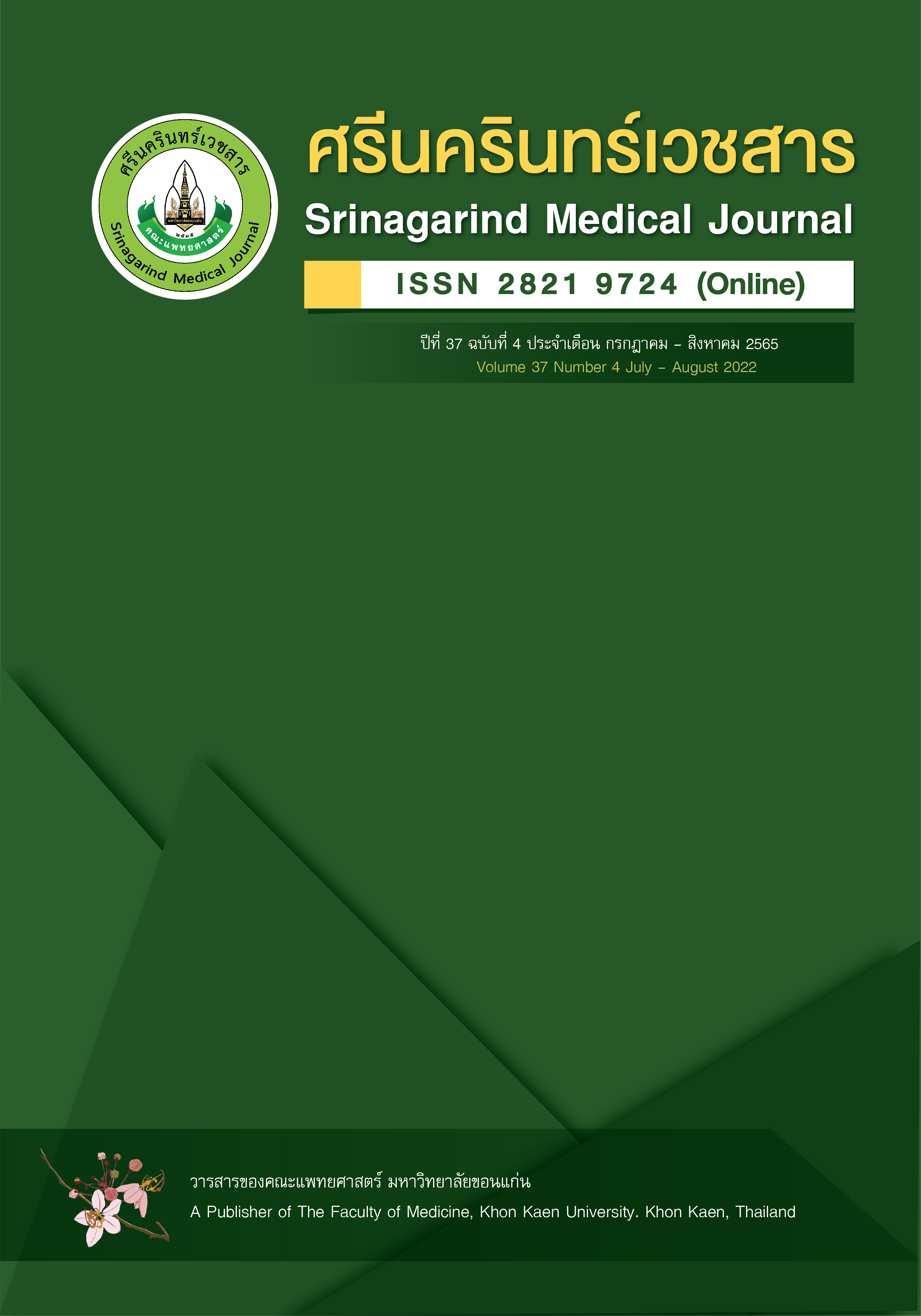ผลตรวจอัลตราซาวนด์ช่องท้องของประชากรกลุ่มเสี่ยงในหน่วยคัดกรองมะเร็งท่อน้ำดีด้วยอัลตราซาวนด์แบบครบวงจร
Abdominal Ultrasonographic Findings of Risk Population in Cholangiocarcinoma Ultrasound Screening Unit: One-Stop-Service
Abstract
หลักการและวัตถุประสงค์: โรคมะเร็งท่อน้ำดีสามารถรักษาให้หายขาดได้โดยการผ่าตัด แต่ต้องรักษาตั้งแต่ระยะแรก ผู้ป่วยส่วนใหญ่มาพบแพทย์เมื่อมีอาการดีซ่านหรือมะเร็งอยู่ในระยะท้าย อัลตราซาวนด์เป็นเครื่องมือสำคัญในการค้นหามะเร็งท่อน้ำดีระยะแรก ดังนั้นการศึกษานี้จึงมีวัตถุประสงค์เพื่อศึกษาความชุกของโรคมะเร็งท่อน้ำดี และลักษณะผลตรวจอัลตราซาวนด์ช่องท้อง
วิธีการศึกษา: ศึกษาย้อนหลังเชิงพรรณนาโดยทบทวนข้อมูลทางการแพทย์ของประชากรกลุ่มเสี่ยงในหน่วยคัดกรองมะเร็งท่อน้ำดีด้วยอัลตราซาวนด์แบบครบวงจร
ผลการศึกษา: ผลตรวจอัลตราซาวนด์ช่องท้องในประชากรกลุ่มเสี่ยง 538 ราย (เพศชาย ร้อยละ 26.4 หญิง ร้อยละ 73.6) พบความชุกมะเร็งท่อน้ำดี ร้อยละ 0.2 จากผลอัลตราซาวนด์ช่องท้องผิดปกติ 392 ราย (ร้อยละ 72.9, ชาย ร้อยละ 78.2 และหญิงร้อยละ 71) พบลักษณะที่สงสัยมะเร็งท่อน้ำดี 6 ราย (ร้อยละ 1.1) คือ ก้อนและท่อน้ำดีในตับขยายตัว ก้อนอย่างเดียว หรือท่อน้ำดีในตับขยายตัวอย่างเดียวอย่างละ 2 ราย ซึ่งมีไขมันพอกตับ 2 ราย เนื้อตับปกติ 2 ราย ตับแข็ง 1 ราย และเนื้อตับเปลี่ยนแปลง 1 ราย ผลตรวจเอกซเรย์คอมพิวเตอร์สงสัยอย่างสูงว่าเป็นมะเร็งท่อน้ำดีระยะแรก 1 ราย (ผลพยาธิวิทยาเป็นมะเร็งท่อน้ำดี) สงสัยมะเร็งท่อน้ำดีหรือมะเร็งตับ 2 ราย (ผลตรวจคลื่นแม่เหล็กไฟฟ้าสงสัยมะเร็งตับ 1 ราย ผลพยาธิวิทยาเป็นมะเร็งตับ 1 ราย และตุ่มเนื้อในตับแข็ง 1 ราย) นิ่วในถุงน้ำดีร่วมกับท่อน้ำดีอักเสบ 1 ราย ท่อน้ำดีส่วนปลายตีบแคบ 1 ราย และหลอดเลือดขอดที่ตับ 1 ราย นอกจากนี้พบไขมันพอกตับร้อยละ 37.4 และพังผืดรอบท่อน้ำดีร้อยละ 16.5
สรุป: การให้บริการหน่วยคัดกรองมะเร็งท่อน้ำดีด้วยอัลตร้าซาวนด์แบบครบวงจรพบความชุกของโรคมะเร็งท่อน้ำดีค่อนข้างสูง การตรวจคัดกรองดังกล่าวสามารถค้นหามะเร็งท่อน้ำดีระยะแรกได้ ซึ่งเป็นกระบวนการสำคัญที่ทำให้ประชาชนได้เข้าถึงการวินิจฉัยและรักษาโรค และเป็นการตรวจเบื้องต้นที่ชี้แนะให้ตรวจเอกซเรย์คอมพิวเตอร์หรือคลื่นแม่เหล็กไฟฟ้า
คำสำคัญ: อัลตราซาวนด์, การคัดกรอง, มะเร็งท่อน้ำดี
Background and objective: The only potentially curative treatment for patients with early-stage cholangiocarcinoma (CCA) is surgery. Most of CCA patients go to the physician at late stage or developing jaundice. The ultrasound is an important tool in CCA screening for detecting early-stage CCA. The purpose of the present study was to define the prevalence of CCA and identify abdominal ultrasonographic findings.
Material and methods: This retrospectively descriptive study, the authors reviewed the medical records and abdominal ultrasonographic findings of CCA risk population in CCA ultrasonography screening unit: One-Stop-Service.
Results: Among 538 risk populations, there were 26.4% male and female 73.6%. The prevalence of CCA is 0.2%. There were 72.9% with abnormal ultrasonographic findings (392 cases, 78.2% male, 71% female). In addition, ultrasonography diagnosis demonstrated the appearance for suspicious CCA in 1.1% of cases (6/358) , which 2 cases had mass plus dilate intrahepatic duct (IHD), 2 cases had only mass and 2 cases had only dilate IHD. There were 2 fatty liver or normal liver each, and there was either cirrhosis or liver parenchymal change. One was diagnosed to highly suspicious for CCA by computerized tomography (CT), which the pathologically proven to have CCA. 2 cases were CT diagnosed to suspicious for CCA or hepatoma (HCC), which one case was MRI diagnosed to HCC (the pathologically proven to have cirrhosis with regenerative nodule) and one case the pathologically proven to have HCC. 3 cases were CT diagnosed to have hemangioma, gallstone plus cholangitis and distal common bile duct stenosis. Moreover, there were 37.4% fatty liver and 16.5% periductal fibrosis.
Conclusion: The prevalence of CCA has been high in the CCA ultrasound screening unit. The CCA screening by ultrasound is very useful in order to identify the early CCA cases, which will benefit for the patients interm of diagnosis and treatment. The ultrasound used to suggest additional CT or MRI.
Keywords: Ultrasound, Screening, Cholangiocarcinoma (CCA)


